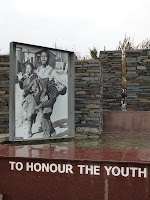 |
| Soweto |
A visit to Soweto is recommended if you want to get an idea about what Apartheid was about and what it meant for the local people. The basic aim of Apartheid was to segregate society based on colour but it led to much more than that; very congested and low quality living conditions for the local Africans.
 |
| Soweto |
 |
| Mandela House |
 |
| Pieterson Museum |
And the the third place we stopped at was where the freedom declaration was made. Reading about what was included in the declaration makes you wonder how such basic rights also needed to be fought for!
 |
| Freedom declaration |
Another thing I realised when there was that in the different rungs of society, the Indians in South Africa had fared a lot better. Even though they were also segregated, they still got education and were able to get decent jobs. That is one of the reason, they did not protest as much against Apartheid, and that is why even today, they are doing better than the local Africans.
After the trip to Soweto, I spent a couple of hours at the Apartheid Museum. I had heard a lot about the Museum, but honestly was not impressed. Its a huge museum There is a lot of information in the Museum, it is just not presented in a great manner to create maximum impact. There is a lot of text written everywhere, but not as many exhibits to take the message forward.
 |
| Apartheid times |
I also got a chance to look at diamonds and tanzanites which are a speciality of South Africa and Tanzania respectively. The diamonds were the same as they usually are, but the tanzanites were something else. They are blue coloured rare stones found only in a mine near Kilimanjaro, and once exhausted, the stone itself will finish. I checked a couple of those in the Sandton City mall and other wholesalers there, and was impressed. An interesting buy, especially if its going to be extinct soon!
The next day, I visited a historical site, the Cradle of Humankind about an hour away from Joburg. Its the site where fossils of the oldest humanoid have been found. We did a tour of the Sterkfontein Caves, and the guide took us through the archeologists finds over the century and seemed proud of the fact than humanity had originated out of Africa. The cave he took us through was a usual one, with stalactites and stalagmites and some fossil remains still inside. However, what I found interesting was the underground lake that we saw inside the cave, apparently its depth is unknown and after 40 meters, divers had stopped searching for its end. I for one have never before seen an underground lake, so found that most interesting in the tour.
 After the caves, I visited the Lion Park nearby. Its almost like a zoo with a couple of animals like cheetah, lions, meerkats, hyaenas, leopards and black leopards kept in cages. It also has a game drive where you can see white lions, plus activities like walk with the cheetah and feed the giraffes. So I would say a pretty commercialised zoo. However what drew me to the park was that they have lion cubs there with whom you can play and get photographed with!
After the caves, I visited the Lion Park nearby. Its almost like a zoo with a couple of animals like cheetah, lions, meerkats, hyaenas, leopards and black leopards kept in cages. It also has a game drive where you can see white lions, plus activities like walk with the cheetah and feed the giraffes. So I would say a pretty commercialised zoo. However what drew me to the park was that they have lion cubs there with whom you can play and get photographed with!
 I stood in a queue for half an hour to do just that. We got two minutes in an enclosed area where there were three cubs to play with. They were soooo cute and even more lazy, so not at all enthusiastically posing for photos. And surprisingly, their coat is not as soft as it appears to be. I feel for the cubs though, how irritated would anyone be if all day, people come and play with you. But I still loved it:).
I stood in a queue for half an hour to do just that. We got two minutes in an enclosed area where there were three cubs to play with. They were soooo cute and even more lazy, so not at all enthusiastically posing for photos. And surprisingly, their coat is not as soft as it appears to be. I feel for the cubs though, how irritated would anyone be if all day, people come and play with you. But I still loved it:).
That was mostly what touristic stuff there is to do in Johannesburg. Wasn't something out of this world, but was good anyways for a nice hectic weekend. The high for me was playing with the cubs and shopping for tanzanites though:) rather than the historical stuff.






No comments:
Post a Comment